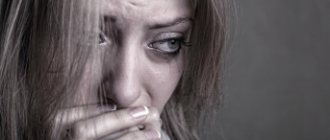Spectrophobia is the fear of seeing a mirror or mirror image. Another type of this phobia is eisoptrophobia. This fear arises in a person when he sees his image in the mirror.
A person may sometimes experience fear from mirrors, be afraid of his own reflection in the mirror. But such manifestations occur only occasionally and do not cause panic and neuroses in people. Eisoptrophobia and spectrophobia are constant panic reactions.
When a person experiences the following symptoms like:
- Trembling and tremor;
- Labored breathing;
- Dizziness, fainting;
- The emergence of fear of death;
- Hot flash or chills;
- Feeling of suffocation;
- Feelings of unreality of events or objects;
- Fears of loss of control;
- Numbness in the whole body or parts of it;
- Chest pain;
- Nausea;
- Dry mouth.
If at least two signs appear during anxiety or stressful situations, then this will already be a manifestation of a phobia.
Statistics say that 500 million people around the world have some kind of mental disorder. Each of 4 teenagers has phobias that appeared earlier in them. Even in childhood, about 5% have mental disorders, in old age – 10% . According to statistics, eisoptrophobia and spectrophobia are among the most common phobias among people.
The consequences of the disease are a person’s isolation and wariness, constant nervousness. Such people cannot lead a normal life when they are constantly afraid of seeing a mirror or their reflection. They are insecure, full of complexes and aggressive. This condition must be treated independently or with the help of doctors. It all depends on the severity of the disease.
Spectrophobia – fear of mirrors
Fear of mirrors develops for various reasons. There are several forms of violation. For example, a person may only avoid his own reflection. Eisoptrophobia is the fear of seeing yourself in the mirror. This problem is often associated with body dysmorphic disorder, i.e. lack of acceptance of one's own body.
Another violation has been identified. Spectrophobia is the fear of any mirror surfaces. Anything that can give off a reflection will frighten a person. This form is more dangerous, it is more difficult for a person to exist with it.
Catoptrophobia is another name for the fear of mirrors. Sometimes it is associated with fear of ghosts or the other world. A person is afraid of seeing something paranormal, so he avoids reflections.
Reasons for development
Fear of water - as it is scientifically called
It is impossible to say unequivocally why this or that phobia develops. Psychoanalyst Ferenczi identified two reasons for the development of phobia: fear of self-knowledge and flight from exhibitionism.
Every person should know not only his soul, but also his body. Due to various disturbances of perception, a person may be afraid to see his bodily embodiment. Sometimes he subconsciously feels disgust towards him.
Sometimes a person considers reflection to be a form of exhibitionism, i.e. sexual deviation. He may not call his behavior fear, but this will not prevent him from avoiding reflections.
With pathological low self-esteem, a person perceives himself negatively. Therefore, any reflection will provoke self-criticism. In this case, the patient will prefer not to deal with what causes him unpleasant feelings.
Impressionable people may be prone to believing in superstitions. In magic, a mirror is a passage to the other world. Therefore, patients will avoid looking into it.
Why does a phobia appear?
There are a number of reasons why a person may develop a fear of mirrors.
- Disgust for one's own appearance. A person may have birth defects: scars or burns, squint, excess weight. He may be too critical of himself. Such people consider their shortcomings so terrible that they prefer not to see them.
- The appearance is not accepted by the personality. This problem occurs in young girls with weak self-esteem.
- Superstition. There are a huge number of beliefs on the topic of mirrors. Many of them say that a mirror is a portal to the world of the dead, so a person is afraid to look in the mirror in the dark so as not to meet evil spirits.
- Fortune telling at midnight with candles and mirrors can frighten an impressionable person, which leads to eisoptrophobia.
The reasons may lie in childhood: an impressionable child does not laugh in the laughter room, but receives psychological trauma for life.
Features of the violation
Fear of insects and bugs - what is the name of the phobia?
Before choosing a treatment method, you need to have a good understanding of what spectrophobia is. With such an illness, a person cannot act consciously, since fear is of an irrational nature.
In severe cases, uncontrollable panic attacks appear
A phobia of mirrors often occurs against the background of childhood trauma. At night, shadows or other unclear silhouettes can be seen in the reflective surface. The child’s imagination completes the picture, and he sees monsters. The feeling of fear remains with him until adulthood.
Important! A room of distorting mirrors can cause fear, as distorted pictures can seriously frighten a child.
Spectrophobia in English is called spectrophobia. This disorder rarely develops against the background of sexual trauma. With it, a person is afraid to see the reflection of his naked body, because... perceives him as someone else's.
Mirror phobia can be called differently. With eisoptrophobia, a person is afraid not only of mirrors, but also of any reflective surfaces: shop windows, puddles, glass, sunglasses, etc. Even a smooth, varnished desktop surface can cause a panic attack.
Sometimes a phobia is combined with other disorders. For example, a patient may consider some part of the body to be ugly, so he will prefer not to see it again.
Psychologist's advice
Fear can be of a different nature. The psychologist answers questions and gives useful advice. What should I do if I'm afraid ?
Reflective surfaces
If the fear is strong, it is recommended to remove large mirrors from the room and leave small ones to avoid panic attacks.
A person should calm down and try to distract himself from negative thoughts.
Fantastic films and books can reinforce fear. They should be abandoned during treatment. You need to be able to distinguish fiction from truth. Thoughts about non-existent things need to be banished.
We must remember that mirrors and reflective surfaces cannot physically cause harm. They are absolutely safe . You must try to convince yourself that mirrors are not dangerous.
Reflections
When passing by a mirror, it is recommended to smile at yourself and not frown . You need to create a positive impression. You should not look for flaws in your own reflection. You need to praise yourself for your success and give compliments.
Let the contact last a few seconds at first, the main thing is not to give in to fear.
Gradually the person will look in the mirror longer and the fear will disappear. To relieve anxiety and excitement, it is better to use medications and herbal teas.
Mirrors in the dark
Usually behind this fear lies the fear of evil spirits, ghosts .
Getting rid of this fear on your own is not easy.
The first thing you need to understand is that most fears are far-fetched . Thoughts about parallel worlds must be eliminated. Don't give in to them.
If the fear is strong, it is really better not to look in the mirror in the dark. However, you should understand that mirrors do not pose a danger even in the dark.
Additionally, it is recommended to take soothing herbal teas, listen to relaxing music before bed, and take a bath. This will help relieve anxiety .
Development of esoptrophobia
Fear of losing a loved one - what is the name of the phobia?
The fear of reflection in the mirror does not appear overnight. Often the disease develops against the background of general dissatisfaction with life and the accumulation of inferiority complexes.
The disorder develops gradually over a long period of time
The person may not notice that their behavior has changed. He begins to quietly avoid mirrors, cover them with cloth or remove them from the apartment. Anxiety and restlessness will increase gradually. The patient will have an obsession that the reflection brings something bad.
Any disorder has a name, this is important for diagnosis. Treatment depends on the correct diagnosis. Phobias often develop in childhood, but can make themselves felt in adulthood.
In this case, any stress or traumatic situation will serve as a catalyst for the problem. People with a high level of sensitivity are more prone to rapid development of the disorder.
Essentially, the spectrophobe is afraid of himself. He doesn’t want to think about old age, because the reflection will remind him of inevitable changes. He may be confused by the future, since thoughts about this period will only cause negativity. A mirror always gives an impartial reflection, forcing a person to see his real self.
How to overcome fear?
Patients are helped through medications and psychological assistance. Only an integrated approach helps to overcome a phobia.
Medicines
Patients need medications to relieve anxiety and anxiety.
Medicines are aimed at normalizing sleep and eliminating panic attacks.
The most effective drugs are:
- Passifit;
- Persen;
- Valordin;
- Dormiplant.
These are sedatives containing sedatives. The duration of administration and dosage are determined by the doctor individually.
Sleeping may also be needed :
- Zolpidem;
- Piklodorm;
- Zaleplon;
- Clomethiazole.
These are representatives of the third generation of sleeping pills and are safe for the body. However, only doctors can prescribe them.
If panic attacks occur more and more often, the phobia is rapidly developing, you need to think about using more effective medications. We are talking about tranquilizers :
- Phenibut;
- Midazolam;
- Amizil.
Doctors recommend taking antidepressants , as they effectively combat mental disorders:
- Heptral;
- Paxil;
- Zyban.
The selection of medications is carried out by a specialist. You cannot purchase them yourself, as this can worsen the condition.
Psychological help
Experts use several methods to eliminate phobias. Each method is effective in its own way:
- Psychoanalytic psychotherapy . Used if fear is associated with childhood trauma. Therapy is quite long. Requires a lot of effort from the client. You will have to visit a specialist often, but this method is one of the most effective.
- Cognitive-behavioral approach. Used for cosmetic defects. Therapy is aimed at processing oneself, accepting one’s “I”. The client will have to reconsider his attitudes and do a lot of work to combat fear.
- Help from a psychologist and sex therapist . Necessary if the phobia appears against the background of sexual dysfunction. A person loses faith in himself, disgust for his own body appears. The help of two specialists can quickly get rid of the phobia.
- Group therapeutic work . Patients share their experiences in a group and support each other. Together we fight fear. It helps not only to eliminate fear, but also to consolidate the achieved results.
How to overcome claustrophobia? Read about it here.
What happens if you look in the mirror for a long time? Find out from the video:
Symptoms and signs of the disease
Spectrophobia can manifest itself in varying degrees, it all depends on the severity of the disorder. At the initial stage, problems may appear only when the room is dark or at night.
Important! All symptoms are conventionally divided into psychological and physiological.
In his own apartment, the patient may be afraid of meeting the object of fear. If the disorder becomes severe, he will remove all mirrors and potentially reflective surfaces from the home.
It’s more difficult to leave the apartment. On the street you can see glass surfaces that will create reflections. Some stores are equipped with mirrored display cases. In sunny weather, any water can create the same effect.
When confronted with the object of their fear, the patient experiences a panic attack. From the psychological side, it manifests itself as restlessness, anxiety and a desire to hide somewhere, to run away. At such moments, a person is not aware of his actions.
During a panic attack, the patient exhibits inappropriate behavior. He may scream, cry, become hysterical, or try to break the mirror.
From the physiological side, a panic attack manifests itself:
- Increased pressure;
- Rapid heartbeat;
- Heavy sweating;
- Tremor of the limbs;
- Dizziness;
- Nausea;
- Vomiting;
- Headache, etc.
Symptoms may not appear all together; sometimes a panic attack is accompanied by minor disturbances. In severe cases of spectrophobia, a person experiences derealization, i.e. he feels like an outside observer of what is happening.
If left untreated, fear of mirrors can lead to serious problems. In this case, the violation will cause the development of diseases of the central nervous system and cardiovascular problems. Neuroses, stress, pressure surges will lead to early stroke and heart attack.
Sometimes spectrophobia is a consequence of a problem with the body, rather than the cause. With a high level of anxiety, a person is especially impressionable, which can lead to various disorders.
If left untreated, the disorder will only progress and lead to complications.
A phobia of mirrors develops against the background of suppressed emotions. In this case, they will accumulate and eventually break through in moments of stress. Therefore, it is important to monitor your condition and identify violations in a timely manner.
Treatment methods
To get rid of spectrophobia, it is better to use an integrated approach. It consists of combining drug therapy and psychotherapy. Only a combination will achieve good results.
Traditional approach
To normalize the functioning of the nervous system, the doctor prescribes B vitamins, tranquilizers, and antidepressants. These medications help restore peace of mind, reduce anxiety and improve sleep patterns.
In the correction, the main role is given to psychotherapy. During it, a specialist analyzes the patient’s life and helps him discover the cause of the disorder. After this, you can change your attitude towards her.
Cognitive behavioral therapy differs in that it works on childhood attitudes. The roots of a phobia may lie in poor upbringing or trauma. In this case, a specialist helps you rethink your behavior.
Another therapy option is gradual habituation to fear. Little by little the person is shown the object of his fear, with each session the interval of the meeting increases.
Important! The training process should be carried out under the supervision of a specialist.
Sometimes a psychotherapist can talk about a phobia in an exaggerated form. After he receives an emotional response from the patient, he shows him that there is no danger in fear.
Self help
When faced with an object of fear, a person needs to close his eyes, slowly inhale and exhale. Repeat 10 times, this will calm the nervous system and prevent it from getting out of control.
Following a daily routine will help maintain the functioning of the body at a high level.
At the moment of panic, you can count the rosary or forcefully switch your thoughts to something monotonous, for example, listing irregular verbs in English.
Spectrophobia poses a serious threat to human health. Therefore, when it appears, you need to immediately begin treatment. The sooner a problem is identified, the faster it can be solved.
help yourself
Since social phobia is not a severe mental disorder, an individual suffering from it is theoretically capable of self-healing. This, oddly enough, will be helped by one of the symptoms – criticality. To do this, a person should sort out his own life story and understand exactly which episode became fatal and analyze it.
Self-help can also be an option such as speaking. That is, after each alarming episode, the patient recounts what happened in great detail. If you do this every time after an incident, regularly and without fail, then, in the end, social anxiety will become less acute and will recede.
However, it should be understood that not everyone will be able to bring themselves back to normal “with their own hands.” Moreover, self-medication does not at all guarantee that traumatic circumstances will ever make themselves felt again in a more negative way. So it is more advisable to contact a specialist - a psychotherapist or psychologist.
In Russia, according to the latest data, about 5–10% of the population suffer from social phobia at different stages of life. Most of them attribute their condition to excessive timidity and other personal shortcomings. Only some people a little under 30 years old are aware of their problem when other neurotic disorders join it. At first they try to solve it on their own, but, having suffered a fiasco, they decide to ask for help from those who know how to help them normalize their social potential. It is important for them to know any information about social phobia and methods of getting rid of it.










